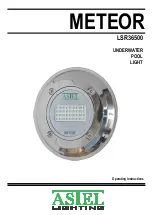
26
SQUARE, LEVEL, AND MAIN DRAINS
SQUARING THE POOL WALLS
After all pool walls are assembled,
for rectangle pools
you’ll want to measu
re the completed
pool wall assembly to insure it is square and parallel. Do this by measuring the inside length and
width for your pool. Also measure both diagonals for straight wall pools and the steel check for
radius pools. An easy way to achieve squaring is by setting an alignment string along the
bottom length of the pool wall, and straightening a long wall first. Recheck the widths of the
pool at the corners. Then measure the diagonals of the pool corner to corner. When the
dimensions are equal, the pool is squared.
Straighten the remaining walls.
When the wall assembly is square, starting
in the corners drive half of a rebar stake
through the holes in each bottom flange and
into the shelf. (Put rebar on the inside or
outside of radius panels). Depending on the
rib configuration of the panel, the rod may
need to be angled slightly to allow access for
a hammer to strike it. The rod helps keep
each panel properly positioned. While
holding a level on its face, verify that the
wall is plumb and drive the stake home. Fix
its position by threading a 3/8"-16 x 1" bolt
through existing or newly drilled holes in the
socket and stake. Lock the bolt in place with
a nut. Make sure the walls remain plumb.
If you have not done so already, brace your
step(s). Use a 2 x 4 wooden plank and rebar to
hold the step into place. This will assist in
keeping your step in place when it comes time
to pour the concrete footer.
TIP
Some braces
and/or soil
conditions
require the use of
treated steel
stakes. Low air
temperature
and/or firm soil
may require the
use of a wooden
block or durable cap to be placed over the top
of the stake while driving it home.
TOOLS
Rebar stakes, Hammer/Mallet, Tie Wire, Duct Tape, Measurer, Transit/Water Level, String,
Screwdriver, PVC glue, Excavation Tools
















































